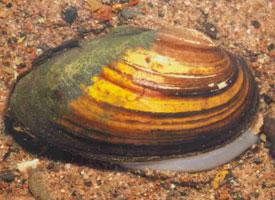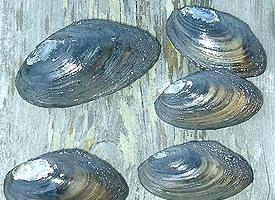
Description de l'animal
The Duck Mussel, scientifically known as Anodonta anatina, is a captivating species of freshwater mussel that belongs to the family Unionidae. This bivalve mollusk is native to a wide range of freshwater habitats across Europe and parts of Asia, thriving in slow-moving rivers, canals, lakes, and ponds. Characterized by its remarkable adaptability, the Duck Mussel has garnered attention for its ecological significance and unique biological features.Physical Characteristics:
Anodonta anatina possesses an elongated, somewhat asymmetrical shell that can grow up to 15 centimeters in length, although sizes around 10 centimeters are more commonly observed. The shell's outer surface showcases a color palette that varies from dark brown to greenish or even black, often adorned with faint growth lines that mark the passage of time. The interior of the shell, or nacre, presents a smooth, iridescent surface, shimmering with shades of silver, blue, or pink. This lustrous interior not only serves as a protective layer for the mussel's soft body but also contributes to the species' aesthetic appeal.
Ecology and Behavior:
Duck Mussels play a pivotal role in their aquatic ecosystems. They are filter feeders, drawing in water to extract oxygen and food particles, such as plankton and detritus. This feeding behavior not only sustains the mussels but also contributes to water purification, making them invaluable for maintaining the health of freshwater ecosystems. Anodonta anatina has a somewhat sedentary lifestyle, anchored to soft substrates like mud or sand by their muscular foot, though they can relocate if necessary.
Reproduction and Lifecycle:
The reproductive cycle of the Duck Mussel is fascinating and complex. They are dioecious, meaning individuals are distinctly male or female. In the breeding season, males release sperm into the water, which is then drawn in by females for fertilization. The females incubate the fertilized eggs in specialized gills called marsupia, where they develop into larvae known as glochidia. Once matured, these glochidia are released into the water, where they must attach to the gills or fins of a suitable fish host to continue their development. This parasitic phase is crucial for the dispersal and survival of the species, as it allows the young mussels to be transported to new habitats. After a few weeks, the glochidia detach from their host, settle on the substrate, and grow into juvenile mussels, completing their life cycle.
Conservation Status:
While Anodonta anatina is not currently listed as endangered on a global scale, its populations are facing threats from habitat destruction, pollution, and the introduction of invasive species. These challenges underscore the importance of conservation efforts to preserve freshwater habitats and ensure the survival of this and many other species dependent on such ecosystems.
In summary, the Duck Mussel, Anodonta anatina, is a remarkable freshwater bivalve with significant ecological roles in its natural habitats. Its unique life cycle, characterized by a parasitic larval stage, and its ability to purify water through filter feeding, underscore its importance in aquatic ecosystems. Despite facing environmental threats, the Duck Mussel continues to be a subject of interest for scientists and conservationists alike, highlighting the interconnectedness of life in freshwater environments.
Animaux similaires
Nouvelles photos d'animaux
Top 10 des animaux
- Dolphin gull (Leucophaeus scoresbii)
- Diana monkey (Cercopithecus diana)
- Moustached guenon (Cercopithecus cephus)
- Galápagos tortoise (Geochelone nigra complex)
- Russian tortoise (Testudo horsfieldii)
- Stone loach (Barbatula barbatula)
- Japanese macaque (Macaca fuscata)
- Greek tortoise (Testudo graeca)
- Common flying dragon (Draco volans)
- Vendace (Coregonus albula)


